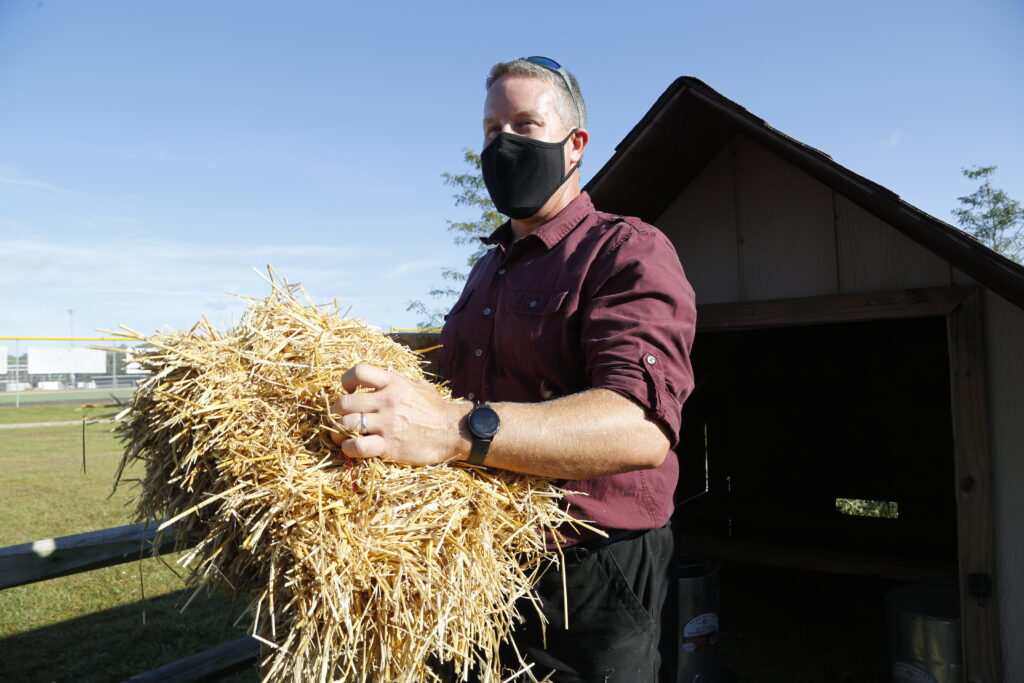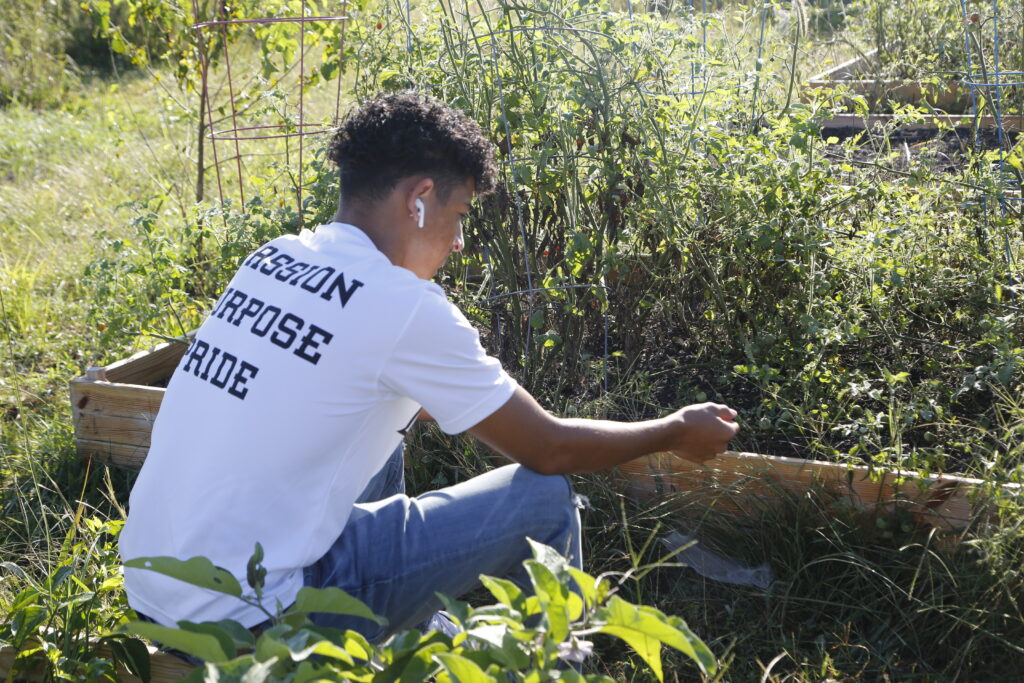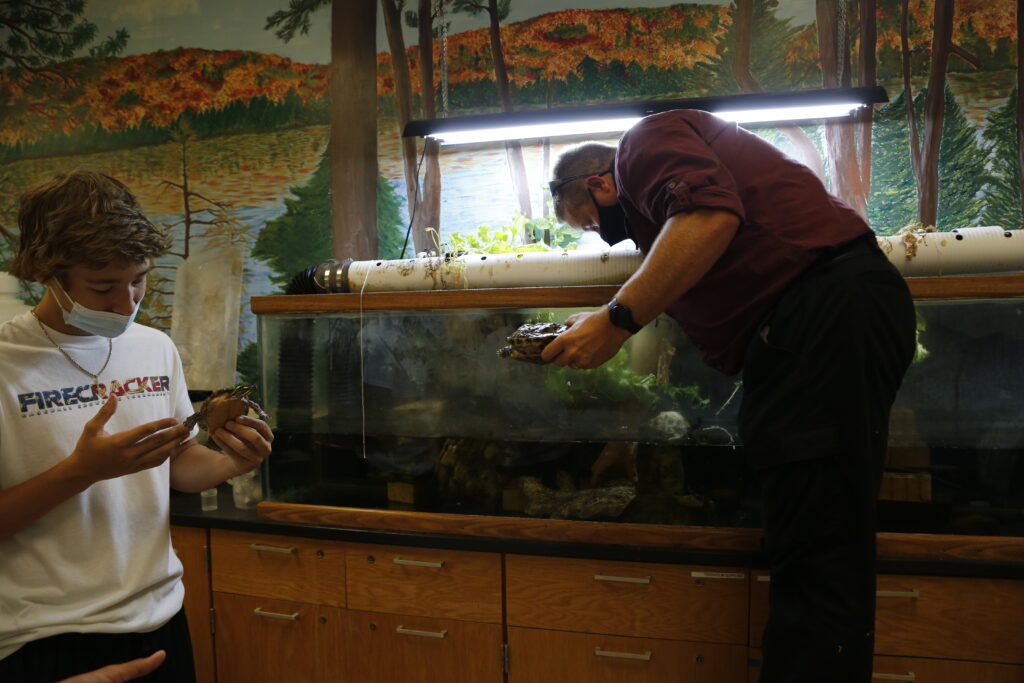By Kathryn Coulibaly
In the shadow of Egg Harbor Township High School (EHTHS) in Atlantic County, environmental science teacher Jim House walks students through their outdoor classroom, taking note of the changes that have occurred as summer slips into fall. Tall grasses grow alongside native trees and bushes. There is a surprisingly neat compost section and pumpkin vines spill out over a raised bed. Tomato and pepper plants past their prime slowly decompose.
For House, who attended EHTHS, and whose mother was a long-time elementary school teacher in the township, getting students outdoors is a practical goal that reaps unexpected rewards.
“I enjoy taking them outside and seeing them get their hands dirty,” House said. “I grew up half a mile from the school, and I would spend my weekends hiking in the woods around here, just exploring. Many of these students don’t have that level of comfort outdoors, and they appreciate the opportunity to learn more about our habitat.”
At the same time, House acknowledges that it’s just fun digging in the dirt.
“I think we need to talk more about how to have fun as an educator in the classroom, particularly the science classroom,” House said. “When I was growing up, science classes were about what you wrote down in the lab book and recreating lab exercises. There was a focus on following instructions. But as I got older, I realized that I don’t like sitting in a laboratory or working at a desk and crunching numbers. I love being outside, collecting data, and getting involved. And I feel like that’s what gets the kids excited about science.”

Grants and student projects help develop outdoor classroom
To help get students working outside, observing and collecting data from the field, House envisioned an outdoor classroom. Beginning in 2006, he won a Wildlife Habitat Incentive Program grant to plant native species to develop an outdoor native species habitat on school property. What is now the outdoor classroom started as an open field behind one of the baseball fields that wasn’t being used for any purpose. With administrative approval, House and his students began work by digging out a pond and planting more than 2,000 trees. Each year since then, they have been slowly developing it, expanding it, and adding more elements.
One of the most striking features of the outdoor classroom, in addition to the pond, which now contains an active and vocal frog community, is the chicken hutch. At one time, the surrounding area was well-known for chicken farming, but many of these students have never encountered a live chicken in real life. The chicken hutch was made possible through a $2,000 award House received for being named one of 2017’s Axalta and Philadelphia Eagles All Pro Teacher of the Year.
“Each year, we hatch chickens in the spring and we put them out in the chicken coop,” House said. “The students go out and feed them and take care of them for the second half of the year. At the end of the school year, we give the chickens away to people who raise chickens. The students get to experience caring for chickens, observing their behaviors and collecting their eggs.”
Many staff members have contributed to the effort. After a production of “The Sound of Music,” the wire gazebo that had been on stage was moved to the outdoor classroom, an attractive structural element flanked with native bushes, including beach plums, which the students sample.
The addition of raised beds was made possible by a grant received last year from the Gro More Good Grassroots Grant Program. This enabled students to grow produce, which they are welcome to take home, and experience the growing process.
A covered area of the outdoor classroom, complete with a white board and picnic tables, facilitates instruction. Several bird houses dot the outdoor classroom, and students learn which birds are native to our area and how to identify them.
Students also contributed a great deal, including an Eagle Scout who helped design and build part of the outdoor classroom. A Girl Scout Gold Award recipient installed a tree identification trail as their final project. Students in the environmental classes have designed and built each area of the garden.

A growing outdoor program grows more possibilities
As the outdoor classroom has grown, so have the possibilities. As freshmen, students taking biology are able to observe outside what they are learning about from textbooks and videos. As juniors and seniors, students are much more involved in the garden and each class is able to raise whatever they would like in one of the 12 raised beds.
“It’s become a legacy project,” House said. “Students like to come back and see what we’ve done and also point out what projects they worked on before. It builds enthusiasm for our science program and a sense of community.”
Several graduates of EHTHS have gone on to careers in environmental science, such as working for the Department of Environmental Protection, environmental engineering, and creating sustainability programs to teach children about the environment.
“I’ve got students who are doing jobs that didn’t exist when they graduated because new fields are emerging all the time,” House said.
House is very proud that they have been able to accomplish so much without leaning on the district for financial support. We have received several grants through the Sustainable Jersey for Schools grant program including partnerships with AtlantiCare, NJEA and PSEG. They also have received a grant from—and worked with—the Audubon Society and the Eco-Schools Program.
“Everything we have done has come through grants and relationships,” House said. “Projects like this one can be achieved for free or low cost to the district and everyone can benefit.”
Many other teachers use the outdoor classroom to motivate and inspire students.
“Other teachers will reach out and ask if they can bring their English classes down to read and discuss literature,” House said. “Our special education department really loves using the outdoor classroom and they have gotten very involved. The Holocaust Studies class has been using it. At one point, they asked if they could add a Holocaust memorial garden and plant crocuses. It’s exciting to see other teachers and students respond to the possibilities.”

Expansion of outdoor learning spaces continues
As an environmental scientist, House draws his students’ attention to the way their environment is changing, both positively and negatively. Getting them outside in the outdoor classroom helps them pay more attention to their environment.
“I need to have these lessons that the students will remember,” House said. “My goal in teaching environmental science is obviously to convey knowledge, but I also want to get my students involved in changing the environment, being part of the solution to dealing with climate change and making the world a better, cleaner place.”
To help prepare his current students for new enterprises in a greener economy, House continues to expand the reach of the outdoor classroom. He is focused on their next big project: a greenhouse, which the district has committed to funding.
“We’ve been able to expand our footprint quite a bit from the first iteration of the outdoor classroom,” House said. “Every year, we’ve added on and built more capacity. With the greenhouse, which will be right next to the high school building, we can expand our agricultural studies throughout the school year.”
House sees the outdoor classroom as an important resource to inspire and educate students, and he is always happy to share what he has learned about creating an outdoor classroom with others. As the 2021-22 Atlantic County Teacher of the Year, he is interested in increasing engagement with other educators in his district and across the county.
“Environmental science is a dynamic science,” House said. “It’s constantly evolving; it’s constantly changing. Because I love my subject area and because I can modify how much time I spend on different topics, I’m able to explore areas that really interest my students and teach them the course work while engaging them in a way that is exciting to them. I’m looking forward to collaborating even more with other educators to improve my instruction and share ideas that make learning even more accessible for my students.”
Kathryn Coulibaly is the associate editor of the NJEA Review and provides content and support to njea.org. She can be reached at kcoulibaly@njea.org.